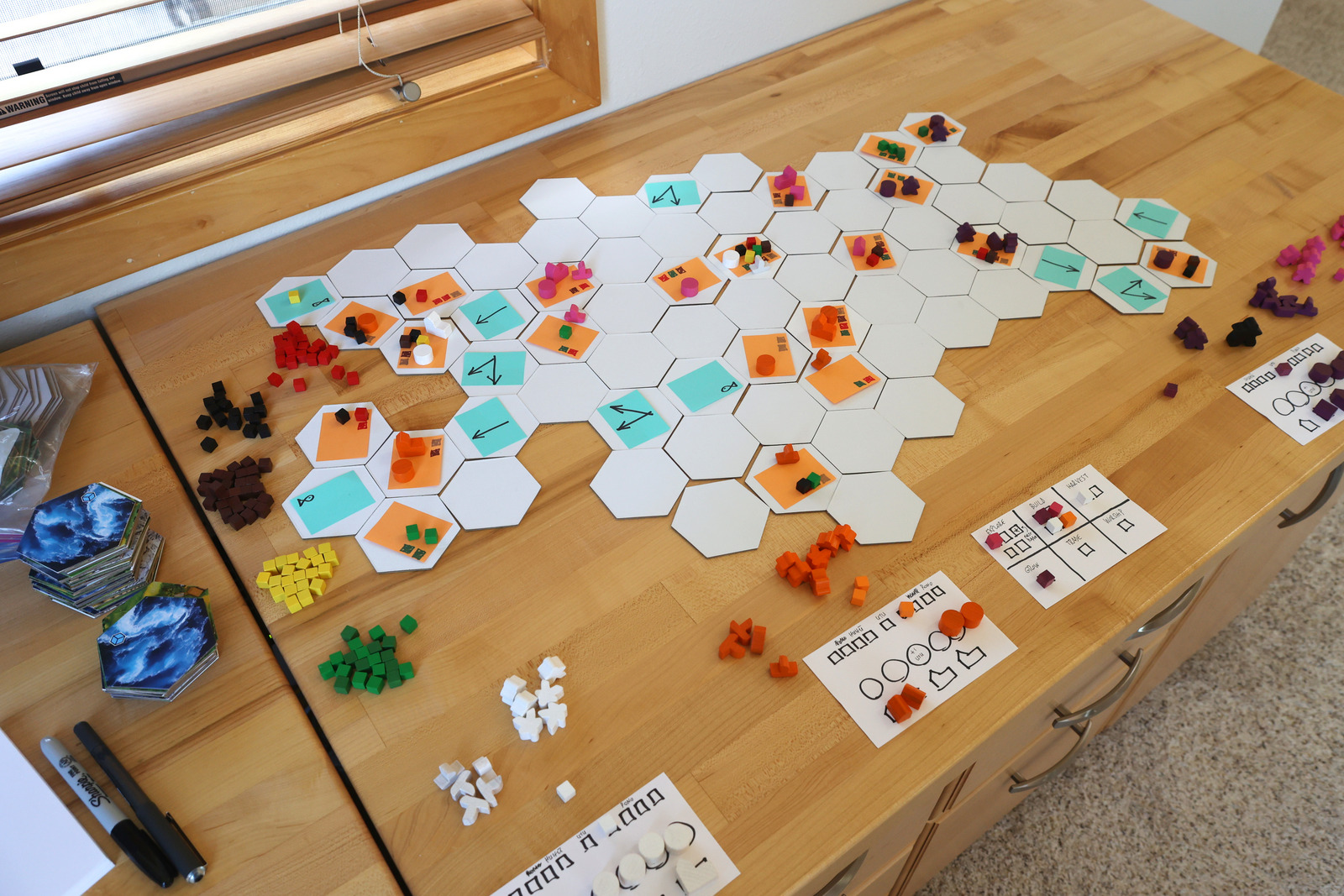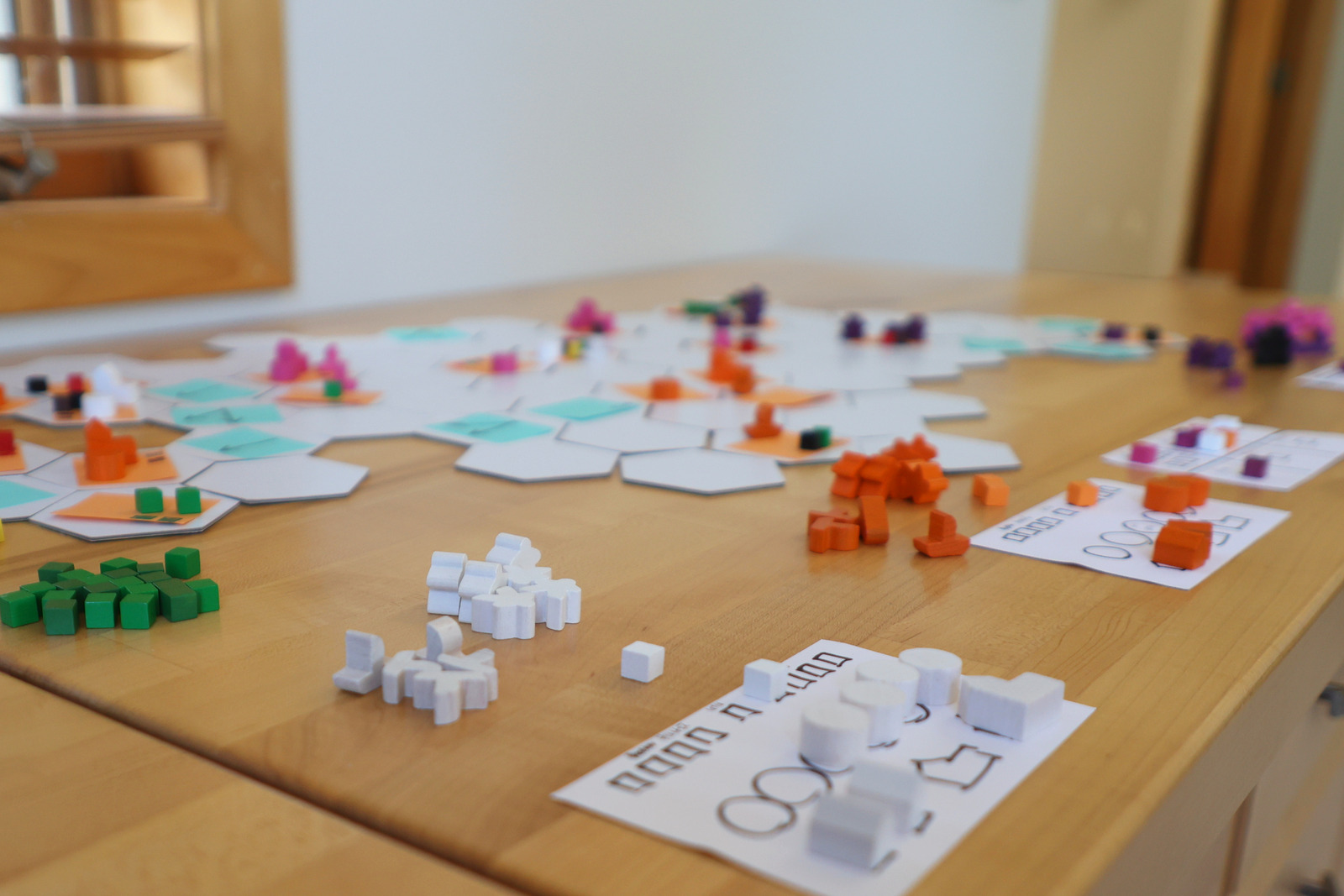I’m still in the process of refining another game I’ve invented. The original title, Forward Humanity, failed in consumer testing (meaning my friends thought it was kind of a lame title). So now it’s been renamed Onward, and after several play-testing sessions, I feel pretty good about it. My friends– and my boys– have given it high marks and made some great suggestions for improvements.

Right now it’s sitting at the printing company, waiting to be put onto “real” cards and player boards. I was getting kind of weary of printing two dozen sheets of cardstock and then cutting out all the cards! I’m excited to see the result and tweak it a bit more.
While I’m waiting a few weeks for the printing process, I had an idea for another game. For a few years I’ve been fascinated by the idea of a game in which you build the playing board while you’re playing the game. There are a few examples of this out in the world, but I wanted to make one myself. I came up with Hexteria: New World and played it with a few people in years past. In it, the first half of the game is spent building a map of the land (prairies, mountains, desert, lakes) and scoring points; the second half is spent building towns and cities on the map and scoring different points. I enjoy it and find it to be an interesting “puzzle” sort of game, but it doesn’t really have much dazzle. Reception by friends has been pretty lukewarm.
So, I came up with a new concept this week. It’s a space map-building game where you’re exploring the galaxy and colonizing star systems. Your spaceships move out, and you draw random hexagonal tiles from a deck to create the galactic map. At some point in the game, someone will turn over a tile that begins the end of the game. In physics terms, it’s called “bubble nucleation” and involves a collapse of spacetime into a “true vacuum” state. This bubble of collapsed spacetime spreads outward at the speed of light, absolutely destroying everything in its path… right down to the subatomic level. In fact, the very laws of nature that hold atoms together break down in this event. The point of the game, after exploring the galaxy, is to escape this universe-ending disaster by slipping into a parallel universe via exotic-matter tunnels through black holes.
That sounds like a lot of science mumbo-jumbo, but in truth it’s all based in real physics. I tentatively named the game False Vacuum, in honor of the notion that we’re all living in a false vacuum right now, and could (theoretically) be wiped out in the blink of an eye when our universe simply ceases to exist. How’s that for a really bad day?
Anyway, science aside, as I tested the game by playing it against myself, I found that it lacked dazzle. There wasn’t anything interesting to do, until the universe collapsed and it became a mad dash for the exits. Even then, it felt stiff and mechanical. After a couple of attempts, I decided it wasn’t going anywhere. Not only did I not enjoy the game, I didn’t see a path to make it better. I tossed it.
But I was still contemplating a map-building game, and I struck upon the idea of giving it an ocean-and-island theme. Exploring the ocean, discovering and settling islands, collecting things… there could be some dazzle there! With some further thought, I decided to base it on Polynesian history. I’ve always been fascinated by the amazing navigational skills of ancient sailors, and the ways they traveled thousands of miles between far-flung islands in the Pacific. I spent a few days studying Polynesian history and culture, thinking about how I could incorporate some of it into my game. To be clear, it’s not my intent to make anything that’s historically accurate– I’m just looking for an interesting theme for the mechanics of the game.
Now, a few days later, I have the beginnings of yet another map-builder. I’m calling it Utu for now, which is the Polynesian word for “balance” (actually it has a far deeper meaning, but that’s it in a nutshell). Everyone starts out on a little island, and heads out in boats to explore the wide blue Pacific. Along the way, players will discover islands and reefs and ocean currents. They’ll gather resources to build more boats, construct villages and temples, and maybe even go to war (I’m not sure about that last one; I typically eschew combat in games). And through all of it, everyone will attempt to keep their mana in balance and harmony.
Here’s the result of my first play-through.


The map turned out to be pretty interesting, and surprisingly “realistic”… if a bunch of white hexagonal cardboard pieces with sticky notes on them can be related to the Pacific islands somehow. And it was fun to play, as I scooted little wooden boats and meeples around the board. But I found that there wasn’t really a goal. What are you supposed to do? How does the game end? How do you win?
Nonetheless, it’s not bad for a first run-through, and I’ll be able to dial it in more over the next few weeks.
I think sometimes this hobby of mine could be considered a waste of time. Yet it provides me with a creative outlet– a way for me to “stretch” myself a bit, since I don’t feel like I’m a very creative person– and despite the failures and scrapped ideas, it’s a lot of fun. I figure there are worse things I could be doing with my time.
So I’ll continue on, hoping to find that utu, balance, in this latest creation.
